This website is supported by its readers. If you click one of my links I may earn a commission. I am also a participant in the Amazon affiliates program and I will also earn a commission from qualified purchases.
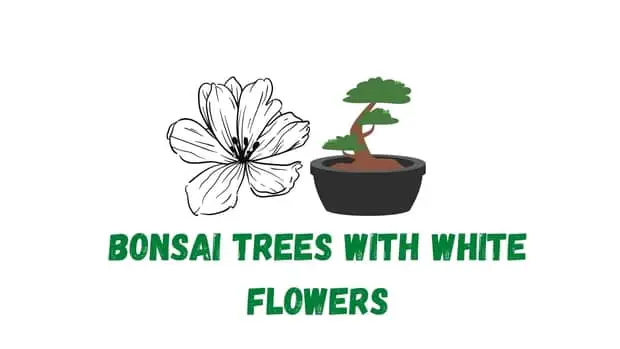
Adding a pop of color to an existing bonsai tree collection can make the difference between a dull collection and a vibrant one. Whilst a lot of people opt for bright reds, yellows, and pinks, bonsai trees with white flowers are becoming more and more popular. So what are the best bonsai trees with white flowers?
Azalea, Japanese Apricot, Jasmin, Fukien tea, Magnolia, and Serissa varieties are the best bonsai trees with white flowers. Other bonsai tree species whose flowers have a white tinge include cherry blossom and powderpuff.
So what are the advantages and disadvantages of these trees? And are these trees beginner-friendly to grow? Keep reading to find out more!
Just a quick heads up, over the past three years of running Plantpaladin, hundreds of people have asked for product recommendations. As such, You can find my favorite indoor bonsai tree here (link takes you to Bonsaiboy), my favorite outdoor bonsai tree (link takes you to Bonsaiboy), or have a look at all the products I recommend here.
Azalea bonsai
So first up are azalea bonsai.
Whilst it might not seem like it because these trees are more shrub-like than anything else, they do make for fantastic bonsai trees and are amongst the most common species out there.
Azalea bonsai | Requirements |
Water | Water if dry to touch - once per day as a minimum. Water once per week in the winter. |
Sunlight | 4 hours of direct sunlight - keep in a shaded spot. |
Fertilizer | Once per month in the spring and summer - Avoid fertilizing in the winter. |
Growth rate | Slow growing - 1 to 5 inches of growth per year. |
Repotting | Repot once every 3 years. |
How white are the flowers?
Whilst azaleas are commonly found in pink and red varieties, they can also be found with bright white flowers.
These white flowers do not have hints of pink or other colors and are amongst the best option should you want a bonsai tree with white flowers.
Azaleas tend to flower between May and June.
Advantages and disadvantages to azalea bonsai
Advantages of azalea bonsai include:
- Smell pleasant – Some azalea varieties not only have beautiful-looking flowers but pleasant smells too.
- Easy to care for – Azaleas are pretty low maintenance only really requiring the care that most bonsai trees will require
- Can be kept indoors – whilst these thrive outdoors, it is possible to keep azaleas indoors too
The main disadvantages of azalea bonsai are:
- White flowers are rare – Most azaleas come with red or pink flowers meaning you need to source these from a reputable source
- Very toxic – The biggest disadvantage to this species is that they are very toxic, even in small portions to dogs, cats, and rabbits, and should be avoided if you own kids or have young children
- Attract pests – the bright white flowers will attract more pests than some of the other species on this list.
Japanese apricot
So a bonsai species that people don’t use all too much has to be the Japanese apricot.
Not only does this bonsai tree produce beautiful white flowers, but it also produces edible apricots that ripen in early summer.
Japanese Apricot | Requirements |
Water | Water if dry to touch - once per day as a minimum. Water once per week in the winter. |
Sunlight | 8 hours of direct sunlight. |
Fertilizer | Once per month in the spring and summer - avoid fertilizing in the winter. |
Growth rate | Medium - 5-12 inches of growth per year. |
Repotting | Once every 2-3 years. |
How white are the flowers?
Japanese apricot bonsai flowers tend to be bright red or pink.
The varieties that fall into white flowers tend to have a hint of light pink or white similar to cherry blossom bonsai.
Japanese apricot bonsai will flower during the winter, with most flowering in December and January.
Advantages and disadvantages to Japanese apricot bonsai
The main advantages of Japanese Apricot bonsai are:
- The produce fruit – Unlike other flowering species, these bonsai produce fruit, meaning you get more for your money
- Not very common – These species are not as common as other bonsai varieties such as elms or ficus’ meaning your tree collections will be unique.
- Can be left outdoors year-round – The species are hardy, meaning they can be successfully winterized outdoors.
The main disadvantages of Japanese Apricot bonsai are:
- They are not bright white – As mentioned the flowers this bonsai produce or more white tinged with pink or red than a clean and clear white.
- Fungal attack – These species tend to be more susceptible to fungal attack than other species.
- Can’t be kept indoors – The bonsai are better suited to outdoor conditions.
Ficus bonsai
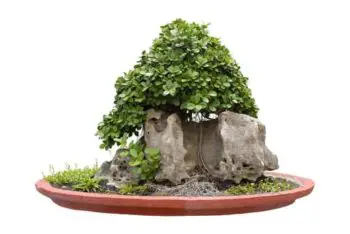
Ficus or fig tree bonsai is without a doubt one of the most popular bonsai species out there.
They are super beginner-friendly and, unlike other species love to be indoors.
Now certain ficus species such as Ficus Benjamina produce white flowers or white flower-like buds that can add a pop to a bonsai collection.
To read up more on how to care for a ficus check out my full post here.
To summarize:
Ginseng Ficus Bonsai tree Requirements | Explained |
Water | Once per day in the spring-summer or if kept indoors. Once per week if kept outdoors during the winter. Only water if dry to touch. |
Sunlight | 4 hours of direct sunlight in the summer. LED grow light can also be used. |
Temperature | Between 60 degrees F and 100 degrees F |
Fertilizer | Fertilize 18 times per year, twice per month between spring and summer. Once per month in the fall and winter |
Repotting | Once every 2 to 3 years in the first 10 years. You can then report once every 5 years |
Placement | Can be placed outdoors in direct sunlight or indoors in a bright spot. |
Wire type | Both copper and aluminum wire can be used. |
Time to grow from scratch into maturity | 8 to 12 years to reach full maturity |
Potting soil | An inorganic Akdama, volcanic ash soil mix works best. |
Growth type | Slow growing, averaging 3-5 inches per year |
Size | Average store-bought trees are size is one or two-handed bonsai trees - 3 to 10 inches in size, 2 to 8 inches wide |
Lifespan | 50 to 150 years |
Fruit | figs |
How white are the flowers?
Ficus Benjamina in particular blooms small bud-like yellowish/white flowers alongside figs.
That being said, these flowers will only bloom if the wasps that pollinate these flowers pollinate the ficus bonsai.
If not, you will end up with a ficus that produces neither figs nor flowers.
Advantages and disadvantages of ficus bonsai
The main advantages of ficus bonsai are:
- Very beginner-friendly – These trees are idiot-proof, making them ideal for a first bonsai tree.
- Can be grown indoors – Unlike other bonsai which need a lot of sunlight, these bonsai are happy to be kept indoors and thrive in these conditions.
- Pest resistant – Fig tree/ficus bonsai are naturally pest resistant and only get infected if they are in poor health.
The main disadvantages of ficus bonsai are:
- Flowers might not bloom – By keeping these bonsai trees indoors or without the wasps necessary for pollination, the vast majority of ficus bonsai kept indoors will not produce fruit or flowers
- Can’t be kept outdoors – If you have a large collection that you keep outdoors, you won’t be able to move these trees outdoors because these trees are very sensitive to cold temperatures.
- Need to be fertilized more frequently – Whilst they are much more low maintenance than other varieties when it comes to fertilizing these trees, they need to be fertilized more.
Fukien tea
Whilst its name might sound like a swear word, Fukien tea bonsai trees like ficus bonsai are amongst the most popular varieties out there.
These species also produce tiny small white flowers across the tree making them an incredibly popular flowering bonsai.
Fukien Tea | Requirements |
Water | Water if dry to touch - once per day as a minimum. Water once per week in the winter. |
Sunlight | 6 hours of direct sunlight. Place near a window if kept indoors |
Fertilizer | Once per month in the spring and summer - avoid fertilizing in the winter. |
Growth rate | Slow; 1 to 5 inches of growth per year. |
Repotting | Once every 2 years |
How white are the flowers?
Fukien tea bonsai trees produce small white flowers across the tree.
Whilst they might be small, they tend to have good coverage across the tree.
These flowers are usually bright white and not diluted by other colors.
Whilst these flowers bloom in the spring and summer, they bloom regularly year-round making them the perfect flowering bonsai.
Advantages and disadvantages of Fukien bonsai
Advantages of Fukien tea bonsai:
- They can produce fruit – If pollinated, these will produce bright red berries to go alongside the flowers – further adding to this tree’s visual appeal.
- Easy to care for – These trees are also very beginner-friendly and can be kept indoors away from any pests.
- A lot of knowledge out there – As these species are so commonplace in bonsai collections, the breadth of knowledge in caring for these trees is massive.
- Bloom year-round – These flowering bonsai are rare in the sense that they produce flowers pretty much year-round.
Disadvantages of Fukien tea bonsai
- The flowers are small – Unlike other flowering bonsai on this list, the flowers that this bonsai produce is much smaller in size.
- Can’t be kept outdoors – Unless you live in a dry warm climate. These bonsai tree species need a hot climate to survive and so thrive in indoor conditions only.
White Cherry blossom

Think of a bonsai tree with flowers and likely the first tree you will think of will be cherry blossom bonsai trees.
A staple for bonsai collectors these trees can produce pink and white blossom and flowers making them an ideal choice for bonsai trees with flowers.
Cherry Bonsai Requirements | Detail |
Water | Once per day in summer, twice per week in winter. Touch to see if the topsoil is dry before watering. Do not water when topsoil is wet. |
Sunlight | 8 hours of direct sunlight in the warm summer months |
Fertilizer | Once per month in the spring and summer. No fertilizing in the fall and winter |
Soil mix | Akadama and volcanic rock mix |
Location | Outdoor and indoors if kept in a warm home. |
Time to grow into mature bonsai | 2-3 years to bloom, 8 years for a mature-sized tree. |
How white are the flowers?
The flowers of cherry blossom bonsai will often start to bloom white and eventually turn pink the riper they get.
That being said, there are some varieties of cherry blossom that flower and stay white year-round, such as the Yoshino cherry.
Cherry blossom bonsai flower and bloom during the spring – between mid-march and early May.
Advantages and disadvantages of white cherry blossom bonsai
Advantages of cherry blossom bonsai:
- They can produce fruit – Some varieties of cherry blossom trees can also produce fruit after a few years of keeping them sowing you to also have a fruiting bonsai tree as well as a flowering bonsai tree.
- Can grow in most climates – As cherry blossom trees are historically grown in east Asia, in moderate climates, these blossom trees can pretty much be grown in most mild climates
- The shedding – Once per year, when the cherry blossom starts to fall, these trees produce beautiful displays. Just be sure that you don’t mind the clean-up!
Disadvantages of cherry blossom bonsai
- Take a while to mature – Cherry blossom bonsai varieties are notorious for being slow-growing. This means that you can be waiting 10 to 15 years for your bonsai to mature before it produces a single white flower.
- Insects and pests – Due to the bright color of the flowers and fruit this tree can sometimes produce, insects and other pests are more likely to be attracted to this variety.
Snow rose tree
A lot of the bonsai trees we have covered so far are deciduous, meaning the leaves fall off during the fall as the preparation for winter.
One evergreen coniferous species of bonsai tree that produces small white flowers would have to be the snow rose tree.
The snow rose bonsai, also commonly known as Japanese boxthorn, or snow goose is a fantastic addition should you want to keep a white flowering bonsai tree outdoors.
Snow rose tree | Requirements |
Water | Water if dry to touch - once per day as a minimum. Water once per week in the winter. |
Sunlight | 6 hours of direct sunlight. Full Sun required. Place indoors should temperatures drop below 10 degrees for winter. |
Fertilizer | Twice per month in the spring and summer - avoid fertilizing in the winter. |
Growth rate | Slow; 1 to 5 inches of growth per year. |
Repotting | Once every 2 years |
How white are the flowers?
The flowers of snow rose bonsai tree, whilst small is incredibly bright and are not diluted by any other color.
Snow rose flowers will bloom in the spring, usually between March and May. It’s not uncommon however for these bonsai to bloom into the late summer in colder climates.
Advantages and disadvantages of snow rose bonsai
The main advantages of snow rose bonsai are:
- Evergreen – Meaning the wood, and leaves will stay tough year-round, ensuring your bonsai tree remains visually appealing.
- Grow lights can be used – While evergreens traditionally do not benefit from using grow light, if this tree is kept indoors during the fall and winter, then grow light can be used to ensure year-round growth on the plant.
The main disadvantages of snow rose bonsai are:
- A lot of sap – These trees produce a lot of sap in the spring meaning any pruning or repotting may need to be pushed into the late summer.
- Have to move indoors – During the winter or when temperatures drop below 10 degrees celsius consistently these trees need to be placed in a warmer environment – They can not be kept outdoors drawing the winter, and are generally susceptible to large changes in temperature.
Powderpuff
If you are interested in the white flowers of your tree not looking like typical flowers and instead of having a more ethereal, puffy, cotton ball type look then the powder puff bonsai (also known as Calliandra schultzei) might be the best bonsai for you.
While it is easy for white flowers from other bonsai trees to get lost in the mix, these flowers will ensure that you have a very unique-looking tree to add to your collection.
Powderpuff bonsai | Requirements |
Water | Water if dry to touch - once per day as a minimum. Water once per week in the winter. |
Sunlight | 6 to 8 hours of direct sunlight. Full Sun required. Place outdoors for best results. |
Fertilizer | Once per week in the spring and summer, once per month in the fall and winter. |
Growth rate | Fast - averaging 12 inches of growth per year. |
Repotting | Once every 2 years |
How white are the flowers?
Whilst powder puff flowers are like cotton balls, they do have a red/pink tinge with them meaning a pure white flower color will also have red and pink in them too.
Some varieties also contain entirely pink flowers so be sure to ask your retailer about the color of the flowers of your tree.
They bloom in the fall and winter.
Advantages and disadvantages of powder puff bonsai
The main advantages of powder puff bonsai are:
- Fast-growing – Most powder puff species used for bonsai are incredibly fast-growing, meaning you won’t have to be as patient as you would with other bonsai trees with white flowers.
- Not as common – This is great as it means this tree will stand out in your bonsai collection, making it unique.
- Good at pruning – Powderpuff trees thrive when being pruned, adding extra ramification when defoliation is carried out.
The main disadvantages of powder puff bonsai are:
- Not all species make great bonsai- Calliandra schultzei and Calliandra haematocephala are both fantastic species of powder puff that are used for bonsai but with over 150 sub-species it can be difficult to find the right species that will make for good bonsai trees.
- More fertilizer – If you get a fast-growing species, it can be more expensive to keep due to the increased amount of fertilizer required for the tree.
- Repotting more quickly – As the species is fast-growing, you will need to also repot this tree more often, making a larger margin of error of weakening the tree.
Magnolia stellata
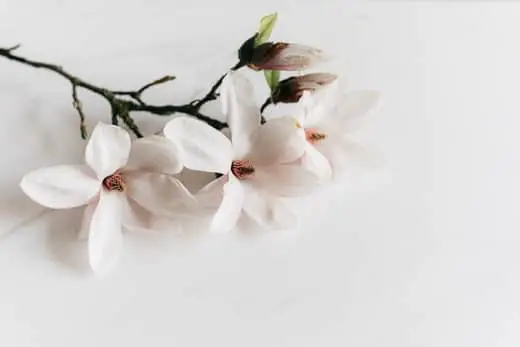
Without a doubt, my favorite bonsai tree with white flowers has to be magnolia stellata bonsai.
Magnolias are well known for these beautiful white flowers – heck it’s why most people paint their houses in this color.
What’s even better is that this plant species can easily be transformed into bonsai or even grown from a seedling.
Magnolia Stellata | Requirements |
Water | Water if dry to touch - once per day as a minimum. Water once per week in the winter. |
Sunlight | 6 hours of direct sunlight. Full Sun required. Place outdoors for best results. Keep in shade in summer. |
Fertilizer | Once per month in the spring and summer. Avoid in fall/winter. |
Growth rate | Slow, averaging 1-5 inches of growth per year. |
Repotting | Once every 3 years. |
How white are the flowers?
Incredibly white, magnolia stellata has bright wide white flowers with a yellow central core. On bonsai, these white flowers are smaller but still pop in color.
Magnolia stellata bloom from May to September.
Advantages and disadvantages of Magnolia Stellata Bonsai
The main advantages of Magnolia are:
- Insect-free – These bonsai are usually good at preventing themselves from common pest infections unless they have underlying issues like mold disease.
- Best magnolia – Whilst other magnolia species can be used for bonsai, the stellata verity is easily the best option. This is because they grow quickly and do not take 30 years to reach full maturity.
- Long bloom – The white flowers these trees produce, start blooming in may to the fall in September.
- Winter-proof – These trees are hardy and can be kept outdoors year-round, so long as temperatures do not drop below -10 degrees Celcius.
The main disadvantages of magnolia are:
- Slow growing – Whilst these species are faster than other magnolia varieties, meaning that you will have to be patient before you get your first bloom of flowers. These trees can take 10 to 15 years to reach full bonsai maturity.
- Better for larger trees – Magnolias tend to grow large meaning they can take up a fair bit of room in a bonsai collection, only keep them if you want to add a medium-sized tree to your collection.
- Can’t keep indoors – as this tree is hardy, it is better kept outdoors.
Jasmine
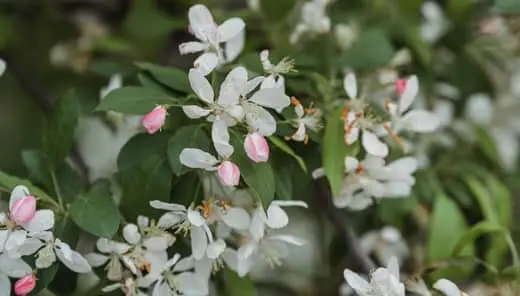
Jasmine bonsai, also known as Cape Jasmine or Gardenia is a very popular bonsai tree species.
With Jasmine already being a world-renowned flower for its bright white flowers and pleasant smelling tree, it’s natural these make for fantastic bonsai trees.
Jasmine | Requirements |
Water | Water if dry to touch - once per day as a minimum. Water once per week in the winter. Water with rainwater if possible. |
Sunlight | 4 hours sunlight. Avoid direct sunlight. Keep in the shade for best results. Move indoors during the winter. |
Fertilizer | Twice per month in the spring and summer. Once per month in the fall and winter. |
Growth rate | Medium, growing 5 to 12 inches per year. |
Repotting | Once every 3 years. |
How white are the flowers?
Jasmine flowers are incredibly bright white, with the color standing out in any bonsai collection.
These flowers are also plentiful, meaning that your bonsai tree will be covered when these flowers bloom.
Jasmine flowers bloom in summer – from June to late September.
The warmer the climate you live in, the more flowers you will have.
Advantages and disadvantages of Jasmin bonsai
The main advantages of jasmine are:
- Plenty of flowers – This tree has plenty of flowers meaning you won’t have to worry about not having a high yield of white flowers
- Pleasant smell – Not only will your bonsai tree have beautiful white flowers if you opt for Jasmin, but you will also have a nice smelling tree.
- Commonplace – A lot of people opt for gardenia jasmine bonsai trees due to their flowers, making the amount of knowledge to care for these trees commonplace.
- Easily propagated – Jasmin can be grown easily, in most climates, from seed or cutting.
The main disadvantages of Jasmin are:
- Needs to be winterized – These bonsai-like warmer temperatures ensure you either place in a cold frame or winterize adequately during the fall and winter.
- Insect attack – Aphids, spider mites, and caterpillars are commonly found eating on this tree’s leaves.
- Prefer rainwater – Due to the tree being an acid-loving tree, use rainwater to water if possible.
- Yellowing leaves – Jasmin bonsai are prone to chlorosis.
Japanese Flowering Quince
If the bonsai trees in your collection are very Japanese-looking stylistically, then I would consider investing in Japanese flowering quince.
Whilst these flowers come in a wide variety of colors, the white flower variety has a snow-kissed look to them.
Japanese Flowering Quince | Requirements |
Water | Water if dry to touch - once per day as a minimum. Water once per week in the winter. Water with rainwater if possible. |
Sunlight | 6 hours of sunlight in summer. |
Fertilizer | Once per month. Avoid in the winter. |
Growth rate | Slow growing - adding 1 to 5 inches per year. |
Repotting | Once every 3 years. |
How white are the flowers?
Japanese quince flowers can be incredibly white if the right species is selected.
This species however has a lot of varieties, with some of the flowers having pink or red tinges to them
Ensure when purchasing your tree or seeds that you get from a reputable retailer, who knows what the color of the flowers will be before you plant it.
Quince varieties tend to bloom in late winter to early spring in most instances.
Advantages and disadvantages of Japanese quince bonsai
The main advantages of Japanese quince are:
- Plenty of flowers – This tree has plenty of flowers meaning you won’t have to worry about not having a high yield of white flowers
- Produces fruit – Alongside the flowers this tree produces, it also has the added bonsai of producing fruit making the tree more visually appealing.
- Easily propagated – Japanese quince can be grown easily, in most climates, from seeds or cutting.
The main disadvantages of Japanese quince are:
- Needs to be winterized – These bonsai-like warmer temperatures so ensure you either place in a cold frame or winterize adequately during the fall and winter.
- Fungal infections – These trees are more likely to be hit with fungal infections and diseases.
- More difficult to find white flowers – The species is most commonly found with red or bright pink flowers. As such, finding white flowers can be difficult so you need to find a reputable retailer
Serissa
So we touched upon the snow rose bonsai earlier on, which is a subspecies of serissa, but many other sub-species varieties of the serissa tree also bloom white flowers.
Some of these include Mt Fuji, Kyoto, and Sparro.
How white are the flowers?
The flowers serissa bonsai tree, vary from sub scopes to subspecies, most fall in between white and pink.
Serissa flowers will bloom in the spring, usually between March and May. It’s not uncommon however for these bonsai to bloom into the late summer in colder climates.
Serissa | Requirements |
Water | Water if dry to touch - once per day as a minimum. Water once per week in the winter. |
Sunlight | 6 hours of direct sunlight. Full Sun required. Place indoors should temperatures drop below 10 degrees for winter. |
Fertilizer | Twice per month in the spring and summer - avoid fertilizing in the winter. |
Growth rate | Slow; 1 to 5 inches of growth per year. |
Repotting | Once every 2 years |
Advantages and disadvantages of serissa bonsai
The main advantages of serissa bonsai are:
- Evergreen – Meaning the wood, and leaves will stay tough year-round, ensuring your bonsai tree remains visually appealing
- Grow lights can be used – while evergreens traditionally do not benefit from using grow light, if this tree is kept indoors during the fall and winter, then grow light can be used to ensure year-round growth on the plant.
- Commonplace – Serissa trees are commonly used in bonsai, meaning a lot of information is out there on the variety.
The main disadvantages of serissa bonsai are:
- A lot of sap – these trees produce a lot of sap in the spring meaning any pruning may need to be pushed into the late summer.
- Have to move indoors – During the winter or when temperatures drop below 10 degrees celsius consistently these trees need to be placed in
- a warmer environment – they can not be kept outdoors drawing the winter, and are generally susceptible to large changes in temperature.
- Not all the species have white flowers – Some of the varieties of serissa are pinker than white so ensure you do your research before purchasing. For best opt for snow rose.
Which bonsai trees with white flowers are beginner-friendly?
Fukien tea, magnolia, and jasmine bonsai tree species all produce white flowers and are very beginner-friendly. They can be grown in most climates, propagate easily from cuttings or seeds, and only require regular watering and fertilizing for successful growth.
How common are white flowers on bonsai trees?
White flowers are incredibly common on bonsai trees. Varieties such as Jasmin, Fukien tea, and magnolia are all very common bonsai tree species that produce white flowers. Other flower colors commonly found are pink and red.
Survey results
Finally, I undertook a quick survey of ten plant paladin readers to ask them what their favorite bonsai trees with white flowers were.
Here are the results:
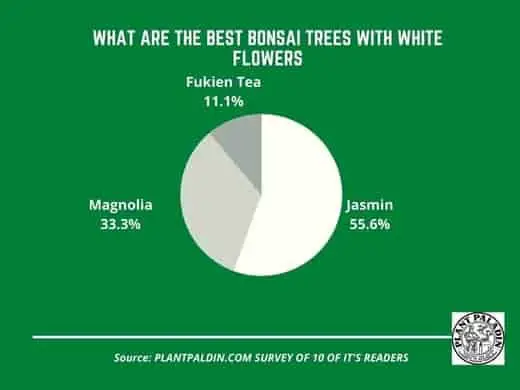
My top picks for the gear you will need!
So like I mentioned earlier, over the past three years of running PlantPaladin, hundreds of people have asked me for my recommendations on the best bonsai gear on the market.
Having spent thousands of dollars on bonsai items these past few years and tested at least 100 bonsai-specific products, I’ve listed my favorite products below – All of which I highly recommend and think you can get great value.
They can purchase directly by clicking the link to take them to Amazon.
Bonsai Tool Set: One of the significant challenges I’ve had is finding a toolset that was not only durable but didn’t break the bank. SOLIGT has recently developed a fantastic bonsai tool set that covers all the tools you need to trim, prune, and repot your trees. – You can grab it here.
Complete Bonsai Set: Many of you will want to grow your bonsai trees entirely from scratch, but finding the varicose seeds, pots, and other items in one place can be challenging. Leaves and Sole then have created a complete bonsai set that I’ve personally used that ticks all the boxes. You can grab it here.
Bonsai wire: The number of times I’ve run out of wire for my bonsai or purchased cheap bonsai wire that doesn’t do the job is embarrassing for me to admit. After a lot of trial and error, I found that using Hotop’s aluminum bonsai wire is one of the best options on the market. This can easily be used for both indoor and outdoor bonsai. You can grab it here.
This post was written by Fehed Nicass who has been passionate about bonsai for over 3 years.
